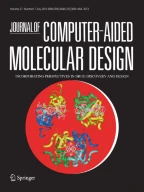Abstract
Prediction of the free energy of solvation of a small molecule, or its transfer energy, is a necessary step along the path towards calculating the interactions between molecules that occur in an aqueous environment. A set of these transfer energies were gathered from the literature for series of chlorinated molecules with varying numbers of chlorines based on ethane, biphenyl, and dibenzo-p-dioxin. This focused set of molecules were then provided as a blinded challenge to assess the ability of current computational solvation methods to accurately model the interactions between water and increasingly chlorinated compounds. This was presented as part of the SAMPL3 challenge, which represented the fourth iterative blind prediction challenge involving transfer energies. The results of this exercise demonstrate that the field in general has difficulty predicting the transfer energies of more highly chlorinated compounds, and that methods seem to be erring in the same direction.
Similar content being viewed by others
References
Dominy BN (2008) Curr Pharm Biotechnol 9:87–95
Raha K, Merz K (2005) Annu Rep Comput Chem 1:113–130
Shirts MR, Mobley DL, Chodera JD (2007) Annu Rep Comput Chem 3:41–59
Moult J (2005) Curr Opin Struct Biol 15:285–289
Battey JND, Kop J, Bordoli L, Read RJ, Clarke ND, Schwede T (2007) Proteins 69(Suppl 8):68–82
Geballe MT, Skillman AG, Nicholls A, Guthrie JP, Taylor PJ (2010) The SAMPL2 blind prediction challenge: introduction and overview. J Comput Aided Mol Des 24(4):259–279
Guthrie JP (2009) A blind challenge for computational solvation free energies: introduction and overview. J Phys Chem B 113(14):4501–4507
Nicholls A, Mobley DL, Guthrie JP, Chodera JD, Bayly CI, Cooper MD, Pande VS (2008) Predicting small-molecule solvation free energies: an informal blind test for computational chemistry. J Med Chem 51(4):769–779
Bevington PR (1969) Data reduction and error analysis for the physical sciences. McGraw-Hill, New York, p 73
Bevington PR (1969) Data reduction and error analysis for the physical sciences. McGraw-Hill: New York (Chapter 4)
Guthrie JP (2011) In preparation
Bowman MC, Acree F, Corbett MK (1960) J Agric Food Chem 8:406–408
Biggar JW, Dutt GR, Riggs RL (1967) Bull Environ Contam Toxicol 2:90–100
Miller MM, Ghodbane S, Wasik SP, Tewari YB, Martire DE (1984) J Chem Eng Data 29:184–190
Weil L, Dure G, Quentin K (1974) Zeitschrift fuer Wasser und Abwasser Forschung 7:169–175
Webster GRB, Friesen KJ, Sarna LP, Muir DCG (1985) Chemosphere 14:609–622
Friesen KJ, Sarna LP, Webster GRB (1985) Chemosphere 14:1267–1274
Guthrie JP (1972) Chem. Commun 897–899
Guthrie JP (1973) Can J Chem 51:3494–3498
Brunner S, Hornung E, Santl H, Wolff E, Piringer OG (1990) Environ Sci Technol 24:1751–1754
Fang F, Chu S, Hong CS (2006) Anal Chem 78:5412–5418
Murphy TJ, Mullin MD, Meyer JA (1987) Environ Sci Technol 21:155–162
Dunnivant FM, Coates JT, Eizerman AW (1988) Environ Sci Technol 22:448–453
ten Hulscher TEM, van der Velde LE, Bruggeman WA (1992) Environ Toxicol Chem 11:1595–1603
Author information
Authors and Affiliations
Corresponding author
Electronic supplementary material
Below is the link to the electronic supplementary material.
Rights and permissions
About this article
Cite this article
Geballe, M.T., Guthrie, J.P. The SAMPL3 blind prediction challenge: transfer energy overview. J Comput Aided Mol Des 26, 489–496 (2012). https://doi.org/10.1007/s10822-012-9568-8
Received:
Accepted:
Published:
Issue Date:
DOI: https://doi.org/10.1007/s10822-012-9568-8
